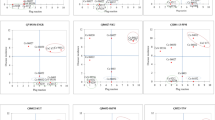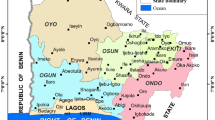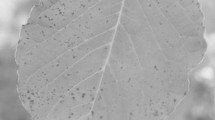Abstract
Red rot caused by Colletotrichum falcatum Went is a serious stalk disease affecting production and productivity in sugarcane. Soil borne inoculum of C. falcatum serves as the major source of primary inoculum in disease epidemics and critically plays a key role in disease cycle. However, information on infectivity of the soil borne fungal inoculum on sugarcane varieties varying in disease resistance, sett germination and disease development is lacking. We have taken up detailed studies on the impact of this inoculum multiplied on sorghum grains on infection of planted setts on a set of 10 sugarcane varieties varying in disease resistance and disease build-up in the field with 11 different pathogenic isolates varying in their virulence. This study suggested a differential behaviour of soil borne inoculum of C. falcatum on vulnerability of sprouting buds, and probably, this primary infection may lead to C. falcatum adaptation in new host varieties.






Similar content being viewed by others
References
Agnihotri, V.P. 1983. Diseases of sugarcane. New Delhi: Oxford and IBH publishing Co.
Chona, B.L. 1950. Studies on the diseases of sugarcane in India. III. Sources and mode of red rot infection. Indian Journal of Agricultural Sciences 20: 363–385.
Malathi, P., R. Viswanathan, and R. Jothi. 2006. Specific adaptation of Colletotrichum falcatum pathotypes to sugarcane cultivars. Sugar Tech 8: 54–58.
Mohanraj, D., and K. Kaverinathan. 2011. The concept of field tolerance and its relevance in screening for red rot in sugarcane. Journal of Sugarcane Research 1(2): 16–22.
Mohanraj, D., P. Padmanaban, and R. Viswanathan. 2012. Screening for red rot resistance in sugarcane. In Functional plant science and biotechnology 6 (special issue 2), ed. R. Viswanathan and A.R. Sundar, 51–62. Ikenobe: Global Science Books.
Padmanaban, P., D. Mohanraj, and R. Viswanathan. 2010. Field tolerance to red rot disease. SBI News 30(2): 1–3.
Pappelis, A.J., and R.A. Katasanos. 1965. An approach to the study of the physiology of senescence and parasitism in sugarcane. Phytopathology 55: 620–622.
Singh, K., T.R. Budhraja, and V.P. Agnihotri. 1977. Survival of Colletotrichum falcatum in soil, its portals of entry and role of inoculum density in causing infection. International Sugar Journal 79: 43–44.
Singh, K., and R.P. Singh. 1989. Red rot. In Diseases of sugarcane: Major diseases, ed. C. Ricaud, E.T. Egan, A.G. Gillaspie Jr. and C.G. Hughes, 169–188. Amsterdam: Elsevier.
Singh, N. and V.P. Agnihotri. 1995. Some soil aspects of epidemiology of red rot disease. In Proceedings of national seminar on sugarcane production constraints and strategies for research and management of red rot. Part II, eds. G.B. Singh, U.S. Shukla, V.P. Agnihotri, O.K. Sinha and R.P. Singh, 294–312, IISR, Lucknow.
Singh, N., S. Lal, V.P. Agnihotri, and D.V. Yadav. 1991. Role of moisture on the development and spread of red rot. Annual Convention of Sugar Technologists Association of India 53: 85–91.
Singh, N., S. Lal, and K. Singh. 1986. Survival of red rot pathogen in sugarcane infected debris. Indian Journal of Sugarcane Technology 3: 125–128.
Srinivasan, K.V. 1962. Some observations on variation in the red rot pathogen, Glomerella tucumanensis (Speg.) Arx & Muller. Proceedings of International Society of Sugar Cane Technologists 11: 795–802.
Srinivasan, K.V., and N.R. Bhat. 1961. Red rot of sugarcane – criteria for grading resistance. Journalof Indian Botanical Society 40: 566–577.
Viswanathan, R. 2010. Plant disease: Red rot of sugarcane. New Delhi: Anmol Publications Pvt Ltd.
Viswanathan, R. 2017. Pathogen virulence in sugarcane red rot pathogen versus varieties in cultivation: Classical case of loss in virulence in the pathotype CF06 (Cf671). Sugar Tech 19: 293–299.
Viswanathan, R. 2018. Changing scenario of sugarcane diseases in India since introduction of hybrid cane varieties: Path travelled for a century. Journal of Sugarcane Research 8(1): 1–35.
Viswanathan, R., P. Malathi, and P. Padmanaban. 2003. Variation in sugarcane red rot pathogen Colletotrichum falcatum Went. In Frontiers of fungal diversity in India, ed. G.P. Rao, C. Manoharachari, D.J. Bhat, R.C. Rajak and T.N. Lakhanpal, 639–667. Lucknow: International Book Distributing Co.
Viswanathan, R., P. Malathi, A.R. Sundar, K. Kaverinathan, M.L. Chhabra, B. Parameswari, and R. Jothi. 2017. Diversity of Colletotrichum falcatum population in India: Comparative virulence at two different agro-climatic regions. International Sugar Journal 119: 966–977.
Viswanathan, R., P. Padmanaban, D. Mohanraj, and R. Jothi. 2000. Indirect ELISA technique for the detection of the red rot pathogen in sugarcane (Saccharum spp. hybrid) and resistance screening. Indian Journal Agricultural Sciences 70: 308–311.
Viswanathan, R., and G.P. Rao. 2011. Disease scenario and management of major sugarcane diseases in India. Sugar Tech 13: 336–353.
Viswanathan, R., R. Samiyappan, and P. Padmanaban. 1998. Specific detection of Colletotrichum falcatum Went causing red rot disease in sugarcane by serological techniques. Sugar Cane 3: 18–23.
Viswanathan, R., A.R. Sundar, R. Selvakumar, and P. Malathi. 2018. Progress in understanding fungal diseases affecting sugarcane: Red rot. In Achieving sustainable cultivation of sugarcane, volume 2: Breeding, pests and diseases, ed. P. Rott, 201–220. Cambridge: Burleigh Dodds Science Publishing.
Yin, Z., and J.W. Hoy. 1997. Effect of stalk desiccation on sugarcane red rot. Plant Disease 81: 1247–1250.
Acknowledgements
The authors are grateful to the Director of the Institute for providing necessary facilities to carry out the work.
Funding
This research did not receive any specific Grant from funding agencies in the public, commercial or not-for-profit sectors. The research work was carried out as part of institutional project work.
Author information
Authors and Affiliations
Corresponding author
Ethics declarations
Conflict of interest
The authors declare that they have no conflict of interest.
Human and Animal Rights
The present research did not involve human participants and/or animals.
Informed Consent
Informed consent was obtained from all individual participants included in the study.
Additional information
Publisher's Note
Springer Nature remains neutral with regard to jurisdictional claims in published maps and institutional affiliations.
Rights and permissions
About this article
Cite this article
Viswanathan, R., Selvakumar, R., Manivannan, K. et al. Behaviour of Soil Borne Inoculum of Colletotrichum falcatum in Causing Red Rot in Sugarcane Varieties with Varying Disease Resistance. Sugar Tech 22, 485–497 (2020). https://doi.org/10.1007/s12355-020-00800-7
Received:
Accepted:
Published:
Issue Date:
DOI: https://doi.org/10.1007/s12355-020-00800-7




